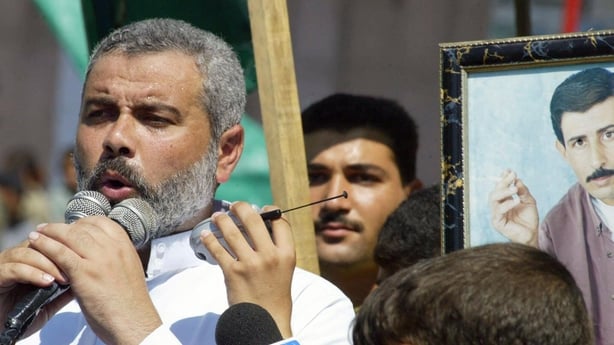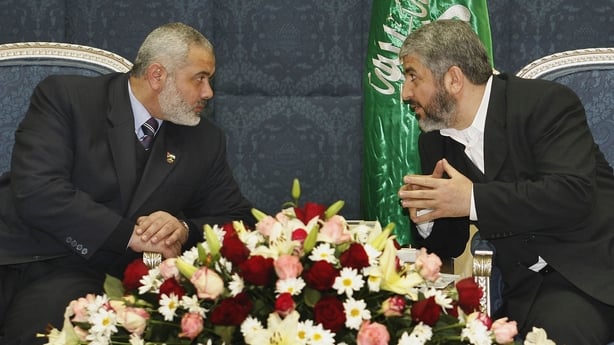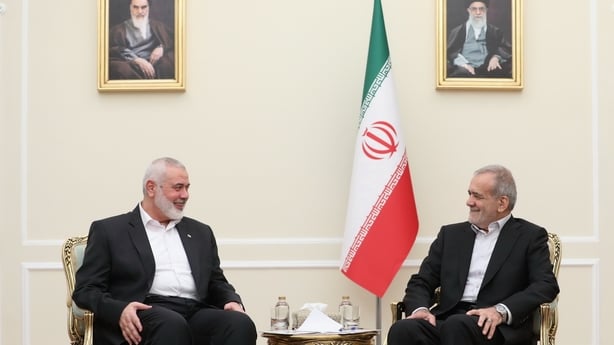Ismail Haniyeh, the Hamas leader who was killed in Iran, was the tough-talking face of the Palestinian group's international diplomacy as war raged back in Gaza.
However despite the rhetoric, the Hamas chief was seen by many diplomats as a moderate compared to the more hardline members of the Iran-backed group inside Gaza.
Appointed to the Hamas top job in 2017, Mr Haniyeh moved between Turkey and Qatar's capital Doha, escaping the travel curbs of a blockaded Gaza and enabling him to act as a negotiator in ceasefire talks or to talk to Hamas' ally Iran.
"All the agreements of normalisation that you (Arab states) signed with (Israel) will not end this conflict," Mr Haniyeh declared on Qatar-based Al Jazeera television shortly after Hamas fighters launched the 7 October raid.
Israel's response to the strike has been a military campaign that has killed more than 35,000 people inside Gaza so far, according to health authorities in the territory.

Sons killed in airstrike
Three of Mr Haniyeh's sons - Hazem, Amir and Mohammad - were killed on 10 April when an Israeli air strike struck the car they were driving, Hamas said. Mr Haniyeh also lost four of his grandchildren, three girls and a boy, in the attack, the militant group said.
Mr Haniyeh had denied Israeli assertions that his sons were fighters for the group, and said "the interests of the Palestinian people are placed ahead of everything" when asked if their killing would impact truce talks.
For all the tough language in public, Arab diplomats and officials had viewed him as relatively pragmatic compared with more hardline voices inside Gaza, where the military wing of Hamas planned the 7 October attack.
Read more: Hamas chief Ismail Haniyeh killed in Iran, group says
While telling Israel's military they would find themselves "drowning in the sands of Gaza", he and his predecessor as Hamas leader, Khaled Meshaal, had shuttled around the region for talks over a Qatari-brokered ceasefire deal with Israel that would include exchanging hostages for Palestinians in Israeli jails as well as more aid for Gaza.
Israel regards the entire Hamas leadership as terrorists, and has accused Mr Haniyeh, Mr Meshaal and others of continuing to "pull the strings of the Hamas terror organisation".

But how much Mr Haniyeh knew about the 7 October assault beforehand is not clear.
The plan, drawn up by the Hamas military council in Gaza, was such a closely guarded secret that some Hamas officials seemed shocked by its timing and scale.
Yet Mr Haniyeh, a Sunni Muslim, had a major hand in building up Hamas' fighting capacity, partly by nurturing ties with Shia Muslim Iran, which makes no secret of its support for the group.
During the decade in which Mr Haniyeh was Hamas' top leader in Gaza, Israel accused his leadership team of helping to divert humanitarian aid to the group's military wing. Hamas denied it.
Shuttle Diplomacy
When he left Gaza in 2017, Mr Haniyeh was succeeded by Yahya Sinwar, a hardliner who spent more than two decades in Israeli prisons and whom Mr Haniyeh had welcomed back to Gaza in 2011 after a prisoner exchange.
Mr Haniyeh had met officials in Egypt, which has also had a mediation role in the ceasefire talks.
As a young man, Mr Haniyeh was a student activist at the Islamic University in Gaza city. He joined Hamas when it was created in the First Palestinian intifada (uprising) in 1987. He was arrested and briefly deported.
Mr Haniyeh became a protégé of Hamas' founder Sheikh Ahmad Yassin who, like Mr Haniyeh's family, was a refugee from the village of Al Jura near Ashkelon.
In 1994, he said that Mr Yassin was a model for young Palestinians, saying: "We learned from him love of Islam and sacrifice for this Islam and not to kneel down to these tyrants and despots."

By 2003 he was a trusted aide, photographed in Mr Yassin's Gaza home holding a phone to the almost completely paralysed Hamas founder's ear so that he could take part in a conversation.
Mr Yassin was assassinated by Israel in 2004.
Mr Haniyeh was an early advocate of Hamas entering politics. In 1994, he said that forming a political party "would enable Hamas to deal with emerging developments".
Initially overruled by the Hamas leadership, it was later approved and Mr Haniyeh became Palestinian prime minister after the group won Palestinian parliamentary elections in 2006 a year after Israel's military withdrew from Gaza.

